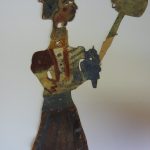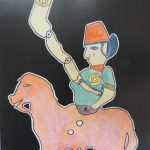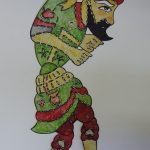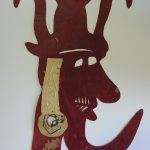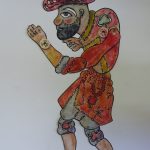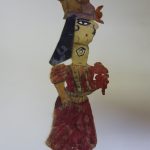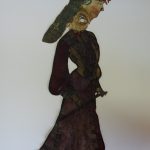
The calendar of the exhibitions to be organized by the Cyprus Museum of Modern Arts within the scope of the November Republic Day events has begun to be cleared. The “Cyprus Turkish KARAGÖZ Images Exhibition”, consisting of the oldest and most original works of Mehmet Ertuğ, the Founding Rector of Near East University Dr. Suat İrfan Günsel’s teacher and the Turkish Cypriot Shadow Play artist, will be opened on Wednesday, November 11, at the Atatürk Culture and Congress Center Exhibition Hall.
100-Year-Old Karagöz copies await visitors …
In the exhibition to be opened on Wednesday, November 11, 2020, the history of the Turkish Shadow Play will be unveiled. Original copies prepared by the oldest Karagöz masters of Cyprus, which Turkish Shadow Play artist Mehmet Ertuğ was able to gather and bring together with great effort, will be exhibited at the exhibition. In addition, a total of 120 original copies of various genres used in Karagöz plays, made by Mehmet Ertuğ himself, will also be exhibited.
Among the figures to be exhibited in the exhibition are Karagöz, Hacivat, Sünbül Hanım, Zenne, Witch, Naked, Keloğlan, Crazy, Hımhım, Albanian, Monster, Greek, Jew, etc. The surrogates consist of works made by masters of Mehmet Efendi of Lefke and Mehmet Ertuğ. The exhibition will also include copies of Mehmet Efendi’s masters made at least a hundred years ago.
Moon and Star Longing Reflects on Karagöz Images
There is a very special copy among the copies that will be exhibited in the “Cyprus Turkish KARAGÖZ Copies Exhibition”. This image, which is one of the most special pieces of the exhibition, is the copy of Mrs. Girl (Mrs. Sünbül). Unlike the other figures, the figure of Sünbül Hanım, which was made of leather by a Cypriot Karagöz master 100 years ago, has the crescent and star on its top and forehead. Mehmet Ertuğ regards this situation as a reflection of the longing that Turkish Cypriots felt for the crescent and star during their years under the British administration.
About Shadow Play and Hacivat-Karagöz…
Hacivat-Karagöz, a shadow play peculiar to Turks, was born in Bursa in the 14th century, according to a legend. The Shadow Play, which has survived to the present day and has made people laugh, think, entertain and criticize for centuries, stands out as one of the most original pieces of Turkish culture. It is believed that it came to Cyprus with the conquest of the island by the Ottoman State.
Hacivat-Karagöz shadow play is so popular on the island that it turns into an indispensable passion not only during Ramadan feast but also in villages and cities throughout the year. Because of this interest, many master Karagöz players are brought up in Cyprus. Besides classical Karagöz plays, Cyprus-specific plays are also performed. In addition to the Karagöz figures, new types unique to Cyprus are also being created. Unfortunately, there is little information left to this day due to the fact that both the copies and the games played are not written down. For this reason, the “Cyprus Turkish KARAGÖZ Copies Exhibition” organized under the leadership of the Cyprus Museum of Modern Arts is of great importance in terms of keeping history and culture alive.
Who is Mehmet Ertuğ?
He was born on March 14, 1939, in the village of Yiğitler (Arçoz). Although he started primary school in the village where he was born, he graduated from Nicosia Haydarpaşa Primary School. After completing his secondary education at the Turkish Cypriot High School in Nicosia, he graduated from Omorfo Teachers College and became a primary school teacher in 1959. In the same year, he entered Gazi Education Institute Turkish-Literature Department with a scholarship. He graduated in the 1960-1961 academic year. Starting from the 1961-1962 academic year, he worked as a teacher and assistant principal in many secondary schools, high schools and colleges of Cyprus. He retired from his profession which he so much loved on July 1, 1987.
Mehmet Ertuğ, who came to his village in his childhood and watched a play of Mulla Hasan, who played Karagöz plays and accepted him as his master, grew up in an environment where the Karagöz play was very popular. He worked on the Turkish Cypriot Theater Games, which he had been curious about from a young age, and especially on Karagöz, in order to keep the folk art in question in Cyprus. Ertuğ, who made his first attempt by performing a live play for his students at Famagusta Namık Kemal High School, where he taught Turkish in the 1962-1963 academic year, presented plays in various cultural events, festivals, festivals and televisions with his own images (descriptions) starting from this date.
On March 27, 1987, the artist, who also opened an exhibition titled “40 Images of the Turkish Cypriot Shadow Play”, which consists of the copies made and played by the Cypriot Turkish Shadow Play artists, occasionally participated in various national and international events, exhibited his plays, taught and gave conferences. In the Traditional Turkish Cypriot Theater, which he founded in 2002 at the historical Great Inn, the first Ottoman-Turkish work in Cyprus, he exhibited the copies of the old Turkish Cypriot Karagöz for many years, as well as performing Karagöz plays continuously. Mehmet Ertuğ, who also offers games with explanations to tourists coming to our country, has over sixty original plays. Around 50 plays of Ertuğ unique to Cyprus, who also has books titled Traditional Turkish Cypriot Theater (1993), Turkish Cypriot Entertainment with Memories and Quotes (2007) and Cyprus Turkish Karagöz Plays (2010), has been recorded and archived by local radio and televisions.

